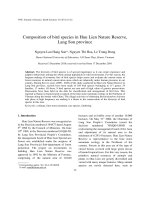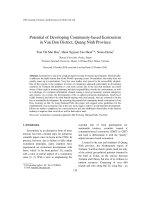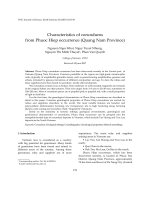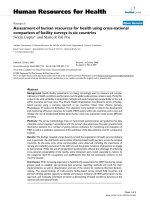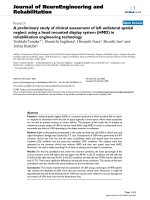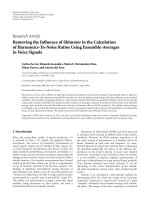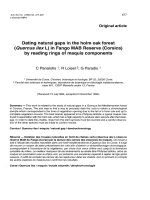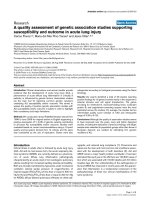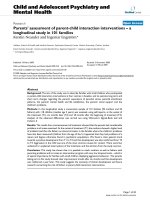Assessment of the diversity of the terrestrial mammal fauna using camera traps in saola nature reserve quang nam province
Bạn đang xem bản rút gọn của tài liệu. Xem và tải ngay bản đầy đủ của tài liệu tại đây (1.26 MB, 71 trang )
MINISTRY OF AGRICULTURE AND RURAL DEVELOPMENT
VIETNAM NATIONAL UNIVERSITY OF FORESTRY
STUDENT THESIS
Title
ASSESSMENT OF THE DIVERSITY OF THE TERRESTRIAL MAMMAL
FAUNA USING CAMERA TRAPS IN SAOLA NATURE RESERVE,
QUANG NAM PROVINCE.
Major: Natural Resources Management
Student:
Do Phu Tien
Student ID:
1453092562
Class: Course: K59B
Natural Resources Management
2014 – 2018
Faculty: Forest Resources and Environmental Management
Advanced Education Program
Developed in collaboration with Colorado State University, USA
Supervisor: Assoc. Prof. Vu Tien Thinh
Hanoi, October 2018
ACKNOWLEDGEMENT
This thesis cannot become a reality without support and help of many individuals. I
would like to extend my sincere thanks to: the heads of Vietnam National University of
Forestry, Faculty of Forest Resources and Environment Management.
As a part of World Wide Fund for Nature (WWF), the Institute for Zoo and Wildlife
Research (IZW) cooperated to conduct a wildlife survey in the Quang Nam Saola Nature
Reserve. This thesis was implemented in partnership with the WWF project, so all the data
from camera traps were contributed by all the team members.
First of all, I would like to express sincere gratitude to my supervisors Assoc. Prof Vu
Tien Thinh and Assoc. Prof Nguyen Phan Thiet has supported me in my studies and related
research, their patience, motivation, and extensive knowledge. Thanks to the guidance of the
two people who helped me during the research and writing of this thesis.
I sincerely thank Mr. Dang Cong Vien, WWF organization, the Quang Nam Saola
Nature Reserves who helped me during the thesis. I am extremely thankful and grateful to
them for sharing experiences, valuable guidance and encouragement extended to me.
Besides, I would like to thank my family, acquaintances for their encouragement, support
during the period of conducting this study. Without their support, I would not have been able
to complete this thesis. This research still has many shortcomings due to the limitations of
time, finance and my ability. I am looking forward to receiving comments from teachers,
friends to a better thesis completion. Thank you!
Hanoi, October 2018
Do Phu Tien
LIST OF CONTENTS
ACKNOWLEDGEMENT ............................................................................................................. i
LIST OF FIGURES ..................................................................................................................... iv
LIST OF TABLES ....................................................................................................................... v
ABBREVIATIONS AND ACRONYMS .................................................................................... vi
ABSTRACT ................................................................................................................................. 1
PART I: INTRODUCTION ......................................................................................................... 2
PART II: GOAL AND OBJECTIVES ......................................................................................... 6
2.1. Goal research ......................................................................................................................... 6
2.2. Objectives research ................................................................................................................ 6
PART III: STUDY AREA............................................................................................................ 7
3.1 The scope of the study area .................................................................................................... 7
3.2 Natural conditions .................................................................................................................. 7
3.2.1. Geographical description .................................................................................................... 7
3.2.2. Geomorphological topography ........................................................................................... 8
3.2.3. Climate and hydrology ....................................................................................................... 9
3.2.4. Land .................................................................................................................................. 10
3.2.5. Fauna ................................................................................................................................ 12
3.2.6. Flora .................................................................................................................................. 13
3.2.7. Habitat types ..................................................................................................................... 13
3.3 Socio-economic conditions................................................................................................... 14
PART IV: METHODOLOGIES ................................................................................................ 17
4.1. Interview .............................................................................................................................. 17
4.2. Camera set up ...................................................................................................................... 18
4.3. Data analysis ........................................................................................................................ 26
PART V: RESULTS AND DISCUSSION ................................................................................ 29
5.1. Mammal species recorded by the camera trap in the Quang Nam Saola Nature Reserve .. 29
5.2. Distribution of some important terrestrial mammal species in the Quang Nam SNR ........ 35
5.2.1. Assessing the conservation status of some mammals in the Quang Nam Saola Nature
Reserve: ..................................................................................................................................... 43
5.3.Threats to fauna in the Quang Nam Saola Nature Reserve .................................................. 46
PART VI: CONCLUSIONS ....................................................................................................... 48
6.1. Conclusions: ........................................................................................................................ 48
6.2. Limitation: ........................................................................................................................... 49
6.3. Suggestion: .......................................................................................................................... 49
REFERENCES
APPENDIX
LIST OF FIGURES
Figure 1: Study site in Sao La Nature Reserve, Quang Nam province ................ 8
Figure 2: Reconyx PC850 Hyperfire Professional White Flax Camera ............. 18
Figure 3 Camera trap location for the coarse grid .............................................. 20
Figure 4 Camera trap location for fine grid ....................................................... 21
Figure 5: Example photographs showing camera trap setup with too much
vegetation (top) and just right (bottom in the green box). .................................. 25
Figure 6: WWF staff are testing the camera trap in the field.............................. 25
Figure 7: Annamite striped rabbit (Nesolagus timminsi) ................................... 36
Figure 8: Locations of Annamite striped rabbit and pangolin ............................ 37
Figure 9: Northern pig-tailed macaque (Macaca leonina) .................................. 38
Figure 10: Dark muntjac species complex (Muntiacus truongsonensis) ............ 39
Figure 11: Locations of Annamite dark muntjac species complex in relation to
the more common red muntjac ............................................................................ 39
Figure 12 Serrow (Capricornis milneedwardsii) was recorded by camera traps 41
Figure 13: Habitat along the streams .................................................................. 42
Figure 14: Habitat protection forests................................................................... 42
Figure 17: Camps for harvesting forest products ................................................ 47
Figure 18: Illegal logging .................................................................................... 47
LIST OF TABLES
Table 1: Composition of terrestrial vertebrates in the Quang Nam Saola Nature Reserve ........ 13
Table 2 Structure of species composition in the Quang Nam Saola Nature Reserve ................. 13
Table 3: Population and inhabitant density under the management of buffer zone communes. 15
Table 4: Ethnic composition of buffer zone communes. ............................................................ 16
Table 5: Camera-trap station ID in the Quang Nam Saola NR ................................................. 24
Table 7: General station information .......................................................................................... 26
Table 8: The number of rare mammal species was recorded in the Quang Nam SNR .............. 27
Table 9 List of mammal species recorded by camera traps ........................................................ 30
Table 10 The comparision of mammal species in Kon Ka Kinh NP, Ba Na - Nui Chua NR and
Quang Nam Saola NR ................................................................................................................ 32
Table 11 The number of photos and frequency of captured animals recorded by camera traps 33
Table 12: The number of rare mammal species was recorded in the Quang Nam Saola Nature
Reserve........................................................................................................................................ 44
Table 13: The main threats to protected areas ............................................................................ 46
ABBREVIATIONS AND ACRONYMS
WWF
World Wide Fund for Nature
NTFPs
Non-timber forest products
NP
National Park
IUCN
International Union for the Conservation of Nature
NR
Nature Reserve
SNR
Saola Nature Reserve
CAL
Central Annamites Landscape
FIPI
Institute of Forest Inventory and Planning
IEBR
Institute of Ecology and Biological Resources
IZW
Institue for Zoo and Wildlife Research
asl
average sea level
ABSTRACT
This study was conducted on investigating the diversity of mammalian fauna in the
Quang Nam Saola Nature Reserve. The Quang Nam SNR has a high diversity of forest
ecosystems, the fauna and flora species. However, there has been limited update on the
changes in composition, number of species, the threats to the species and habitat. The
objectives of this study are to determine the diversity species of mammals, especially in the
presence of the mammals, the conservation values of the species and the threats to the species
and habitats. The main method for data collection is „camera-trapping‟ in the study field.
During the period from 2018.05.01 to 2018 08.30, 25 camera trap locations were established
for the coarse grid phase and 30 camera trap locations were established for the fine grid
phased, resulting in 6,655 camera trap nights. From these efforts, at least 19 mammal species
species were photographed. These results include several species with high conservation
value for the Central Annamites landscape, including two Annamite endemics, the Annamite
dark muntjac (Muntiacus truongsonensis) and Annamite striped rabbit. In addition to wildlife
surveys, the teams recorded human activities in the forest, including illegal activities such as
hunting. Snares were found throughout the study area. These activities have profoundly and
negatively impacted the wildlife of the Quang Nam SNR.
1
PART I: INTRODUCTION
Vietnam is considered one of the Southeast Asia richest in biodiversity and ranked as
the 16th among the highest biodiversity country in the world (Joao et al., 2013) . Due to the
large differences in climate, from the equatorial to the sub-tropical regions, along with the
diversity of topography. The discovery of the Saola (Pseudoryx nghetinhensis) by WWF and
Vietnamese scientists in Vu Quang Nature Reserve, Ha Tinh Province in 1992 (Neville Kemp
et al., 1997) drew the world‟s attention to the biodiversity associated with this mountain chain
at the first time. From then on, the state and government, international organizations have
researched on a number of ecological characteristics, distribution of Saola and concluded that
it is an endemic ungulate of Central Annamites, only in central Vietnam and Laos (Le Trong
Trai et al., 2013). Since that first remarkable discovery, many other new species have been
found, including a number of large mammals such as the large-antlered (giant) and muntjac
(Muntiacus vuquangensis) and the Annamites striped rabbit (Nesolagus timminsi). These
findings highlight the Central Annamites as one of the world‟s most remarkable (Le Trong
Trai et al., 2013). The Central Annamites Landscape (CAL) has been identified through a
systematic global prioritisation process as one of the world most important areas for
biodiversity conservation. In recognition of the importance of the landscape and the need for
an integrated, comprehensive approach to the conservation of the landscape, a major
conservation initiative for Central Annamites Landscape was launched by WWF. However,
the survey initially of WWF, Institute of Forest Inventory and Planning (FIPI), Institute of
Ecology and Biological Resources (IEBR) and many foreign scientists showed that is one of
the Saola distribution also presented in CAL of high biodiversity value and need protection.
Moreover, due to the topographic characteristics and the richness of biodiversity, this area has
become the target state of logging, hunting and exploitation of natural resources beyond the
timber of people in the region as well as from other places, state encroachment of forest land
2
for cultivation, causing loss of biodiversity and direct threat to the habitat of Saola and other
species important for conservation. To address those issues, the establishment of a nature
reserve is very essential in this area. In the 13th July 2012, Quang Nam People‟s Committee
issued Decision No 2265/QD-UBND approved the proposal on the establishment of the Saola
Nature Reserve in CAL. Besides, other measures including camera trapping used for
conserving the biodiversity and habitat of this area are established. The establishment of Saola
NR is significant when it is found that Saola NR is the home to many rare and endangered
terrestrial mammal with high economic and scientific value such as Annamite Dark Muntjac
(Muntiacus truongsonensis), Red-shanked douc langurs (Pygathix nemacus), Grey-shanked
douc langurs (Pygathix cinereus), Crested Argus (Rheinardia ocellata).
In the past, some previous studies were conducted in the Quang Nam Saola Nature
Reserve such as “The survey report on the Saola species (Pseudoryx nghetinhensis) in the
Arec village, Tay Giang district” of Quang Nam Provincial Forest Protection Department in
(1996)– recognized the signs of the skull, horn of the Saola in the village and interviewed
local people; “A study on Saola, ungulates and primates in the Avuong commune, Tay Giang
district and Song Kon commune, Dong Giang district” of MOSAIC project (Barney Long,
Minh Hoang), WWF Vietnam from 2000 to 2006, “Survey on the biological characteristics
and cause habitat degradation of Saola” of many scientists such as Do Tuoc (2007), Nguyen
Xuan Dang (2007). The previous studies were implemented by traditional methods
(observation, visual recognition), there has been still limited to nocturnal species, especially
small mammals group.
Nowadays, the camera trapping method becomes increasingly popular. The
improvement of technology and cost-benefit (Rowcliffe et al., 2008) makes this method
widely used among researchers purposely to detect species presence (Tobler et al., 2008), to
estimate the community structure and diversity (Ahumada et al., 2011), and to determine the
3
activity pattern (Grassman et al., 2006). Systematic camera trapping survey in a large-scale
area to document terrestrial animal species. The baseline information on assessment of
activity pattern of wildlife based on species presence (Tobler et al., 2008), density, evaluation
of conservation programmes and develop approaches of effective management (Karanth et al.,
2006). The accountable and reliable information on spatial or temporal is very useful,
especially in wildlife monitoring. Thus, the objective of this study is to evaluate the trapbased information of terrestrial mammals distribution at the Quang Nam Saola Nature
Reserve in relation to protected area, altitudinal elevations and main water body.
The biggest cause of terrestrial mammalian decline and extinction in the twentiethfirth century is habitat loss and degradation. As human convert forests, grasslands, rivers, and
wetlands for various uses. They relegate many species to precarious existences in small,
fragmented habitat patches. In addition, some terrestrial mammals have been purposely
eliminated by humans. Terrestrial mammals play important roles in tropical forest ecosystem
function, including seed dispersal, herbivore regulation, pollination and carbon sequestration
among others. However, for tropical forests, I have little or limited information on the status
most of the species that is collected consistently through time. The camera trap is one of the
methods and efficient way to monitor the status of species, communities of mammals which
was used to collect data in the field.
In the world, there are many types of research about using camera trap for mammals
diversity. For example, “Activity periods of photo-captured mammals in north-central
Thailand” (Grassman et al., 2006), “An evaluation of camera trap for inventory large- and
medium-sized terrestrial rainforest mammals.” (Tobler et al., 2008) , “Estimating animal
density using camera traps without the need for individual recognition.” (Marcus Rowcliffe
et al., 2008). In Vietnam, there are also have a draft of “Report on primary results of
standardized wildlife survey in Bach Ma National Park from November 2014 to October
4
2015.”. However, the number of studies about using camera traps for surveying mammals is
still limited while the threats of logging, illegal trading animals and climate change could
decline the amount of this species. Starting from the needs above, I proceed to implement the
topic: “Assessment of the diversity of the terrestrial mammal fauna using camera traps in
Saola Nature Reserve, Quang Nam province.”
5
PART II: GOAL AND OBJECTIVES
2.1. Research goal
To have a better understanding of the diversity of the terrestrial mammal‟s fauna in the
Quang Nam Saola Nature Reserve by using camera traps.
2.2. Research objectives
To determine the distribution and status of the terrestrial mammal‟s fauna
To determine the threats of human on the terrestrial mammal‟s fauna diversity in the
Quang Nam Sao La Nature Reserve.
To give some suggestion to raise awareness for the community about wildlife
conservation in the Quang Nam Saola Nature Reserve.
6
PART III: STUDY AREA
3.1 The scope of the study area
This study was conducted on investigating the diversity of mammalian fauna in the
Quang Nam SNR. There are two Saola Nature Reserve in Quang Nam and Hue Provinces but
my research was implemented in Tay Giang district, Quang Nam province. I chose the Quang
Nam SNR for study because the NR is considered an area of important habitat for Saola,
ungulate animals, primates and pheasants. Along with Saola, NR is the distribution of the
Truong Son Muntjac as well as newly discovered large mammals endemic for the scientist in
Central Annamites mountain forest area. In 2011, the People‟s Committee of Quang Nam
province decided to establish Quang Nam Saola Nature Reserve.
3.2 Natural conditions
3.2.1. Geographical description
The Quang Nam SNR is distributed between 17056‟57‟‟ – 18005‟25‟‟ N and
105051‟07‟‟– 106004‟36‟‟ E along the Annamite Mountains (Vu Van Dung, Tham Ngoc
Diep, et al). The site is located in the West of Quang Nam province within four communes of
Bhalee, Avuong, Ta Lu, Song Kon of Dong Giang and Tay Giang district of Quang Nam
province, with a natural area of 15,486.46 ha/ 22 subdivision, a strict protection zone.
The Northern boundary is located between Quang Nam and Thua Thien Hue province.
The Quang Nam SNR is adjacent to the expanded area of Bach Ma National Park.
The Eastern boundary is located between A Ting and Song Kon communes of Quang
Nam province, which is the boundary between 43 and 56 sub-areas of Quang Nam.
7
The Western boundary is located between Quang Nam (Tay Giang and Dong Giang
commune) and Thua Thien Hue province (A Luoi, Nam Dong commune); the remaining part
of the boundary is Viet Nam and Laos.
The Southern boundary is located from East to West starting at the point of intersection
Song Kon and A Ting commune; subregional boundaries from 43 to 57 zone.
Figure 1: Study site in Sao La Nature Reserve, Quang Nam province
3.2.2. Geomorphological topography
The Quang Nam SNR is situated in the area most of the high mountain, dominated by
mountains running from West to East and North to South, with the highest peak of 1,446m on
the border between Quang Nam and Thua Thien Hue province, the other peaks above 1,000m.
Due to the complexity of terrain creation, the terrain is very steep and rough (slope ranges
from 15 to 40o). The North and the Northeast slopes sharply, the Southwestern slope steeper
than others. The fragmentation of the study site is great depth, especially in the North and the
Northeast (300 - 500m), the level of division in the Southwest is weaker (100 – 300m), the
valleys are narrow and almost none. The topography of Quang Nam is characterized by a
8
general highland to lowland gradient from west to east. The province is bordered to the north
by the Bach Ma – Hai Van Mountains; an Eastward running spur of the main Annamite ridge
which itself forms the western boundary of the province.
3.2.3. Climate and hydrology
The Quang Nam SNR is located in humid tropical monsoon and transitional subregion between the North and South of Annamite range, it is divided into two dry and rainy
seasons. Rainy seasons last from September to February having around 1000- 4000 mm
Rainy regime: The annual average rainfall in this area is the largest in comparison with
other areas in Quang Nam province (only after Tra My zone). The average annual rainfall is
from 2,000 to 2,500mm, sometimes reaching up to 4,000mm. The amount of rainfall is
distributed unevenly in the year, annually year from 4 to 5 months with the rainfall below
100mm, the rainfall occurs at the least in June and the most concentrated in October,
November.
Heat regime: The annual average temperature is 23,5oC, the highest temperature is
380C and the lowest temperature is 80C. The month with the highest temperature in June and
July; the lowest temperature in December. The annual temperature is range from 5-7%.
Moisture regime: The relative humidity of the air is related to the heat and rain regime.
The annual average humidity in the area is about 86%. In the rainy season, the moisture
regime is just only about 93% (from September to March next year). In the dry season, the
humidity is about 83% (from April to August ).
Wind regime: The prevailing winds in two main directions are the North-East and
South-West. The Northeast wind lasts during the rainy season from September to February
next year, when the Northeast monsoon occurs cold weather with heavy rain. The Southwest
wind lasts during the dry season from mid-June to end-July.
9
In addition, the region is affected by the storm and Lao winds within 30 m/s from
September to December. Floods often occur from September to November, which is often
accompanied by Northeast wind.
Hydrological: The topography of Quang Nam is characterised by a highland to
lowland gradient, divided into many regions, so it has formed a system of rivers and streams
ranging from 0.5 to 1 km/km2 such as Kon river, A Vuong river, A Poc river, Mo Rang river,
Ta Lang stream, Za Vua stream, R‟Lai stream, B‟No stream, etc.. The characteristics of water
systems are narrow, high slope so the effect of erosion is very large. In the rainy season,
frequent floods cause landslide in both sides of the road, destroy the hydropower construction
as well as bridges. In the dry season, rivers and streams often suffer from drought, so the
irrigation of the land is so difficult. However, the forest cover is quite good and large area, the
thickness of the weathering layer is quite thick, so the capacity of groundwater is quite high.
In the dry season, main streams maintain the flow and downstream rivers flow year-round.
The changes in terrain level, in which there is a high groundwater level at depths of 815m and low groundwater level at depths of 4-8m. At the moment, the underground water
resources have not been exploited effectively, the local people of this area use drinking water
and living from self-flowing water through sedimentation tanks. In the future, if the
underground water is exploited efficiently, it will be required for daily life and irrigation, due
to the high vegetation cover.
3.2.4. Land
a) Feralit red gold on the mountain humus (Humic Acrisols):
- Characteristics: This soil accounts for about 42% of the total natural area, formed
mainly on magma acid and distributed in absolute height from 900m upwards slope from 15 –
10
250, where over 30o. Due to located in high terrain, slope so vulnerable to erosion, Ca2+, Mg2+
are washed away, acidic soil reaction, no low base level (50%), high hydrolytic acidity.
- Direction of use: Most of the area in this soil type is still natural forests, some area
were affected but mild. Therefore, there should be strict measures to protect the existing forest
area; as for the empty forest land area where there is a large slope should to order recovery by
natural regeneration to create habitat for Saola.
a) Feralit red gold on the clay and stone metamorphic (Ferralic Acrisols):
- Characteristics: This soil originates from sandstone, slate, mica, gneiss, etc.. and
distributed in the absolute height from under 900m and concentrate more in the commune:
Bhalee, A Vuong and partially in the commune: Ta Lu and Song Kon. Soil type covers an
area of approximately 36% of the total natural area, on a 1.5m thick layer composition
medium and heavy mechanization.
- Direction of use: This type of land has good properties of soils in the area, the
remaining forest area has been affected strongly. Therefore, the need to protect the remaining
forests and farming to protect the places where bare soil is not the forest and have great slope
to recover by natural regeneration.
b) Feralit red soil on magma acid rock (Ferralic Acrisols)
- Characteristics: The parent rock formed mainly granite, riolite, pegmatite, etc.. are
rich in SiO2 rocks should have formed soils with light mechanical composition, often poorly
structured, soil medium average (usually smaller than 1.2m), the rate of stone less. Soils
covering about 15% of the total nature area, distributed from a height below 900m and mainly
in areas with steep terrain above 150, so it is often eroded in places without forests. Therefore,
it is necessary to protect the existing forest area, so that the forests restored gradually across
the region itself.
c) Alluvial soil stream (Dystric Fluvisols):
11
- Characteristics: This soil type occupies a very small area in the region (about 4%),
distributed mainly in communes: Bhalee, Avuong, Kon river. Land is formed by the sediment
of large river and stream sediment in the area, so the mechanical components is usually crude,
lightweight and more durable mineral resources. Natural fertility depending where very
different, but generally acidic soil reaction to the very acidic, medium humus, total nitrogen,
phosphorus and potassium are poor, thick soil layer is from 70 to 80m.
- Direction of use: Although the area is not much, but this type of land is very suitable
for growing agricultural and also has great significance in resolving the food for people living
in the area. So this land easily affected by local people, there should be safeguards.
d) Other land categories:
In addition, there are another types of land in this area with small area scattered in the
area such as soil valley slope capacitor (Dystric Gleysols), yellow-brown soil on alluvial soil
(Ferralic Acrisols), soil water. These soil occupies about 2% of the total natural area of the
Quang Nam Saola Nature Reserve.
3.2.5. Fauna
In general characteristics, the Quang Nam SNR was considered as a region of high
biodiversity value so this area has been surveyed by many scientists since 1996. The results
showed that the Quang Nam SNR has recorded 463 terrestrial vertebrates species were
recorded in 87 families, 23 orders. (Source: The management plan of the Quang Nam SNR
period 2013-2014 and orientation to 2020)
o Mammal fauna: including 68 mammal species, 24 families, 10 orders.
o Bird species: including 139 species, 30 families, 10 orders.
o Reptiles and frogs:128 species, 24 families, 2 orders One of them, 33 species were
recorded in the Vietnam Red Book (2007), 66 species listed in the IUCN Red List (2010) and.
In particular, there are four species of Indochinese such as Saola (Pseudoryx nghetinhensis),
12
The Truong Son muntjac (Muntiacus truongsonensis), the Red-shanked Douc langurs
(Pygathrix nemaeus), Crested Argus
Table 1: Composition of terrestrial vertebrates in the Quang Nam Saola Nature Reserve
No.
Categories
Species
Family
Order
VN Red List.2007
IUCN Red List 2010
1
Mammals
68
24
10
21
21
2
Birds
139
30
10
7
5
3
Reptiles
128
24
2
16
6
4
Amphibians
128
9
1
22
18
Total
463
87
23
33
66
(Source: The management plan of Quang Nam Saola Nature Reserve period of 2013-2014
and orientation to 2020)
3.2.6. Flora
The flora of the Quang Nam Saola NR has not been investigated fully, but the initial
results record 9 species list under the IUCN Red List (IUCN 2010), 50 species list in Vietnam
Red Data Book (2007) and 9 species belong to Group 1A and 2A of Decree 32/2006/ NĐ CP
Table 2 Structure of species composition in the Quang Nam Saola Nature Reserve
No.
Plant
Order
Family
Species
1
Bryophyta
0
0
0
2
Polypodiophyta
1
3
3
3
Gymnospermatophyta
Basal angiosperms
0
0
0
32
50
82
4
Total
33
53
85
(Source: The Quang Nam Saola Nature Reserve)
3.2.7. Habitat types
There are two main types of forest in the Quang Nam Saola Nature Reserve recognized as:
13
Type of tropical evergreen rainforest at an elevation of 900m or higher:
This forest type is quite large and has all the forest status but the most common are
forest status IIIA1, IIIA2, a bit IIIA3 and some small forest areas IIA, IIB and vacant land IB,
IC. This type of forest, due to the impact of herbicides and bombs uses in the War, which has
been impacted by people, so some forest sites have been affected significantly, except in some
places with high slopes and remote area. In this forest type, there are many valuable species
such as Tram Huong (Aquilaria crassna), Soi duoi (Quercus setulosa), Cau rung (Areca sp.).
There are many valuable orchids species such as Anoectochilus setaceus, Dendrobium
amabile.
Type of tropical evergreen rainforest at elevation of 900m or lower:
This forest type distribution concentrated at elevation bellow 900m, with the main status
as the secondary forest after harvesting masterpiece (IIIA1), secondary forest recovery after
cultivation, forest fires and deforestation (IIA, IIB) and a few areas of grassland shrub grows
after cultivation with the states (IA, IB, IC). The characteristics of this forest type are the tree
stories high from 18 – 22m and create the main canopy of the forest. The plants are mainly
found in Burseraceae, Sterculiaceae, Euphorbiaceae, Annonaceae, Fabaceae, Fagaceae…
Fresh carpet flow representation of Bryophyta, Polypodiophyta, Magnoliophyta. This is the
result of forest areas affected and destroyed by toxic chemicals during the war, and excessive
exploitation of the large trees, as well as the burning of forests for agriculture, should remain
largely secondary forest after harvesting and forest restoration.
3.3 Socio-economic conditions
This is a mountainous commune with 2,037 households with more than 7,900
inhabitants, low GDP, which is one of the poor areas of Quang Nam. In general, the economy
in the region has not developed, people‟s livelihoods are still difficult. Ethnic groups living in
14
the buffer zone of the Saola Nature Reserve are mainly the Co Tu ethnic group accounts for
91,02% and the Kinh group 8,51%, and another ethnic group such as Muong, Thai, Tay, Ta
Oi, Hre accounts for 0,47% (Table 2). The people here are mainly agricultural production,
cultivation, livestock, growing fruit trees, etc. However, due to the lack of investment capital
so the cultivation activities are traditional.
The natural area of buffer zone communes is 37.758,40 ha, of which agricultural land
is 1.874,06 ha, accounting for 4.96%, mainly cultivating annual crops such as rice, maize,
cassava and wet rice cultivation in some narrow areas along streams. The forest land area
accounts for 85.79% of the total natural area, mainly Non-timber forest products,
afforestation, regeneration trees.
Table 3: Population and inhabitant density under the management of buffer zone communes.
No.
Communes
I
Tay Giang district
1
Number
Households
Inhabitants
Density (people/km2)
21
1.055
4.884
18
Bha Lee
8
502
2320
32
2
A Vuong
9
394
1825
12
3
A Nong
4
159
739
13
(Source: According to the statistical yearbook in 2016)
15
Table 4: Ethnic composition of buffer zone communes.
Unit: people
Ethnic groups
No.
Communes
Population growth
Total
Kinh
Co Tu
rate%
Others
1
BHa Lee
2.320
157
2.162
1
20,92
2
A Vuông
1.825
59
1.759
7
19,93
3
A Nong
739
44
692
3
19,13
4
Ta Lu
889
71
811
7
15,57
5
Song Kon
2.268
327
1.926
15
18,13
A Ting
2.253
218
2.020
15
19,27
10.294
876
9.370
48
18,83
6
Total
(Source: According to the statistical yearbook in 2013)
16
PART IV: METHODS
This research was conducted from May 1st to August 30th 2018 in the Quang Nam
SNR. From 1st to 15th May 2018, the camera traps were installed for coarse grid phase and
then I continued to set up for fine grid phase from 10th to 15th July 2018.
4.1. Interview
Regarding Research Objective 2, to analyze of the threats of human on the terrestrial
mammal‟s fauna diversity in the Quang Nam Saola Nature Reserve, I have conducted
interview section focused on local community who lived in Aur village, Tay Giang district,
Quang Nam province. I chose this area for interviewing because there are Co Tu ethnic
people who live near the forest, their livelihood belong to the forest resources and reliable
information from them. I interview focused on the elder local people and forest guards who
often hunting wild animals or go to forests to patrol or exploit forest products. During the inte
rview, the colour photos of animals used to identification of species.
Specimens parts of wild animals are hunted and captured animals also considered for
research. The information about mammal appeared through an interview in order to select the
sites for setting camera traps.
I conducted an interview survey from during the field trip and semi-structured
interviewed with the local community, the forest guards and the Saola Nature Reserve Forest
Management Board Representative. After that, I analyzed the specimens of hunted animals of
the local people and specimens at the animal museum of the Institute of Ecology and
Biological Resources. According to the interviews with households in the community, they
often go to the forest for hunting and trapping wild animals in dry seasons, for trading food
and other consumer goods. Besides, I collected the data through observation and recorded
field notes as well as to involve themselves with study participants.
17
4.2. Camera set up
In this study, I conducted a general literature review on camera trapping using the
Reconyx PC850, which is the white flash camera in the professional hyper fire range. It is
used primarily for wildlife monitoring purposes when colour photos at night are required. The
PC850 will produce images of the highest quality day and night with the exclusive Ultra HD
Infrared camera lens. Reconyx cameras have extra-long battery life using 12 AA size
batteries, enabling the camera to run continuously up to one year.
The operating mechanism of the camera trap is based on infrared sensors and dynamic
sensors. For example, when warm-blooded animals appear in front of the camera, the infrared
sensors will detect and when the heat is moving (e.g animals or leaves), the camera will
record the images.
Figure 2: Reconyx PC850 Hyperfire Professional White Flax Camera
- The objective was record the image and determine the composition of the mammal
species in the study area. Therefore, the setting of camera traps are installed only for image
recognition species. I checked the camera-trap settings before placing the camera-trap in the
field. Important settings to check include:
- Set to photograph mode
- Set to take minimum 3 – 5 photographs in a sequence per trigger.
18
